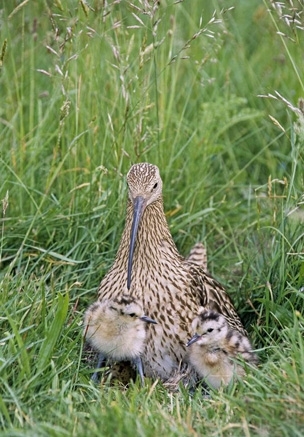 The reasons for curlew population declines have been the subject of much research, and the most important conclusion is that low breeding success is responsible, rather than reduced adult survival1. This is important because it allows us to focus research and conservation efforts on the breeding grounds.
The reasons for curlew population declines have been the subject of much research, and the most important conclusion is that low breeding success is responsible, rather than reduced adult survival1. This is important because it allows us to focus research and conservation efforts on the breeding grounds.
Loss of suitable breeding habitat is a major problem for curlew, with changing techniques in agriculture2, urbanisation, afforestation3,4 and changes in wetland management5 identified as important factors. For southern curlew, modernisation of agriculture, particularly increased management of pastures and wetlands, is likely to have had a large impact.
In addition to habitat pressures, it is well documented that increased predation is a serious threat to curlew breeding success1,2,6. For example, a large review of many scientific studies across Europe demonstrated that 65% of observed curlew nests between 1996-2006 were predated2. This study also found that over 70% of nests were not able to hatch a single chick. Of those that did hatch, chick survival from hatching to fledging (the ability to fly) was only 50%2. In a separate study examining causes of breeding failure in Northern Ireland between 1993-95, nest predation was the predominant cause of breeding failure, with 85-97% of nest failures due to predation6.
In order for the curlew population to remain stable, it would be necessary for curlew to produce, on average, 0.48-0.62 fledged chicks per pair per year6. Less than a chick per year per pair may seem like a fairly low figure, but the estimated breeding success actually documented across Europe is 0.342 – too low to maintain the population, and resulting in the population declines that are being seen. Reported figures for breeding success do vary widely because of local conditions, but the majority reported are inadequate for population stability, and this estimate represents a collection of data from many studies.
As a result of the body of scientific work, it has been proposed that the curlew should be considered the most pressing bird conservation priority in the UK7.
The seriousness of the situation faced by curlew has prompted the EU to publish a management plan for curlew8, and the Agreement on the Conservation of African-Eurasian Migratory Waterbirds (AEWA) has published a European Single Species Action Plan1. These documents comprehensively review all the available science, and summarise it with recommendations for how best the species might be supported.
Despite this, on the ground curlew breeding success remains low, and populations continue to decline. Data on curlew breeding in the south of the UK are limited by the small number of birds remaining, however one report studying breeding curlew in Shropshire in 2016 found that from 21 nests, only three hatched any chicks. None of these chicks survived to fledging9.
Our summary of all the available evidence can be found through the links below, in a Q&A document, as well as a booklet covering curlew conservation. Further important documents are also available.
References and resources
- Brown, D. J. International Single Species Action Plan for the Conservation of the Eurasian Curlew numenius arquata arquata, N. a. orientalis and N. a. suschkini.AEWA Technical Series (2015).
- Roodbergen, M., van der Werf, B. & Hotker, H. Revealing the contributions of reproduction and survival to the Europe-wide decline in meadow birds: Review and meta-analysis. Journal of Ornithology 153, 53–74 (2012).
- Douglas, D. J. T. et al. Upland land use predicts population decline in a globally near-threatened wader. J. Appl. Ecol. 51, 194–203 (2014).
- Holden, J. et al. Environmental change in moorland landscapes. Earth-Science Rev. 82, 75–100 (2007).
- Wilson, A. M. et al. Changes in the numbers of breeding waders on lowland wet grasslands in England and Wales between 1982 and 2002. Bird Study 52, 55–69 (2005).
- Grant, M. C. et al. Breeding success and causes of breeding failure of curlew Numenius arquata in Northern Ireland. J. Appl. Ecol.36, 59–74 (1999).
- Brown, D. et al. The Eurasian Curlew - the most pressing bird conservation priority in the UK? Br. Birds 108, 660–668 (2015).
- European Commission. Management plan for curlew (numenius arquata). (2007).
- Cross, A., Perkins, A. & Tompkins, D. Curlew Country. Shropshire Hills and Welsh Marches Curlew Recovery Project. (2016).
Q&A Factsheets
A future for curlew
Conserving the curlew
Curlew Country report
AEWA single species action plan
European Commission management plan for curlew
Curlew Recovery Group
Abstracts/full text of key scientific papers:
Roodbergen 2012
Wilson 2005
Brown 2015